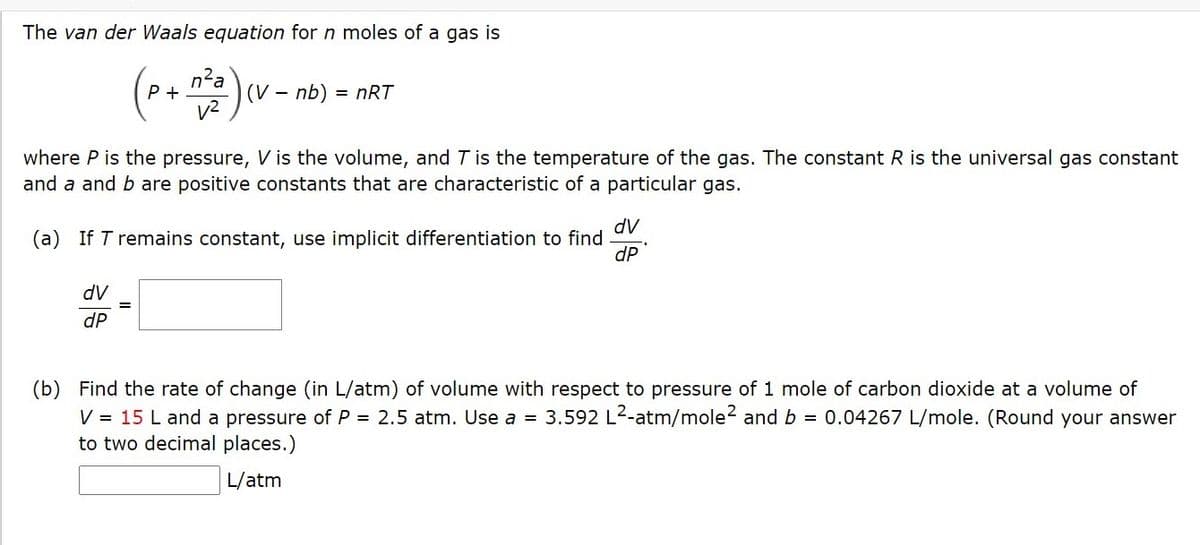The van der Waals equation for n moles of a gas is n?a (V - nb) = nRT v2 P + where P is the pressure, V is the volume, and T is the temperature of the gas. The constant R is the universal gas constant and a and b are positive constants that are characteristic of a particular gas. dV (a) If T remains constant, use implicit differentiation to find dP dv dP (b) Find the rate of change (in L/atm) of volume with respect to pressure of 1 mole of carbon dioxide at a volume of V = 15 L and a pressure of P = 2.5 atm. Use a = 3.592 L--atm/mole and b = 0.04267 L/mole. (Round your answer to two decimal places.) L/atm
The van der Waals equation for n moles of a gas is n?a (V - nb) = nRT v2 P + where P is the pressure, V is the volume, and T is the temperature of the gas. The constant R is the universal gas constant and a and b are positive constants that are characteristic of a particular gas. dV (a) If T remains constant, use implicit differentiation to find dP dv dP (b) Find the rate of change (in L/atm) of volume with respect to pressure of 1 mole of carbon dioxide at a volume of V = 15 L and a pressure of P = 2.5 atm. Use a = 3.592 L--atm/mole and b = 0.04267 L/mole. (Round your answer to two decimal places.) L/atm
Calculus: Early Transcendentals
8th Edition
ISBN:9781285741550
Author:James Stewart
Publisher:James Stewart
Chapter1: Functions And Models
Section: Chapter Questions
Problem 1RCC: (a) What is a function? What are its domain and range? (b) What is the graph of a function? (c) How...
Related questions
Question

Transcribed Image Text:The van der Waals equation for n moles of a gas is
n?a
V2
P +
(V – nb) = nRT
where P is the pressure, V is the volume, and T is the temperature of the gas. The constant R is the universal gas constant
and a and b are positive constants that are characteristic of a particular gas.
dV
(a) If T remains constant, use implicit differentiation to find
dP
dV
dP
(b) Find the rate of change (in L/atm) of volume with respect to pressure of 1 mole of carbon dioxide at a volume of
V = 15 L and a pressure of P = 2.5 atm. Use a = 3.592 L--atm/mole2 and b = 0.04267 L/mole. (Round your answer
to two decimal places.)
L/atm
Expert Solution
This question has been solved!
Explore an expertly crafted, step-by-step solution for a thorough understanding of key concepts.
This is a popular solution!
Trending now
This is a popular solution!
Step by step
Solved in 3 steps with 2 images

Knowledge Booster
Learn more about
Need a deep-dive on the concept behind this application? Look no further. Learn more about this topic, calculus and related others by exploring similar questions and additional content below.Recommended textbooks for you

Calculus: Early Transcendentals
Calculus
ISBN:
9781285741550
Author:
James Stewart
Publisher:
Cengage Learning

Thomas' Calculus (14th Edition)
Calculus
ISBN:
9780134438986
Author:
Joel R. Hass, Christopher E. Heil, Maurice D. Weir
Publisher:
PEARSON

Calculus: Early Transcendentals (3rd Edition)
Calculus
ISBN:
9780134763644
Author:
William L. Briggs, Lyle Cochran, Bernard Gillett, Eric Schulz
Publisher:
PEARSON

Calculus: Early Transcendentals
Calculus
ISBN:
9781285741550
Author:
James Stewart
Publisher:
Cengage Learning

Thomas' Calculus (14th Edition)
Calculus
ISBN:
9780134438986
Author:
Joel R. Hass, Christopher E. Heil, Maurice D. Weir
Publisher:
PEARSON

Calculus: Early Transcendentals (3rd Edition)
Calculus
ISBN:
9780134763644
Author:
William L. Briggs, Lyle Cochran, Bernard Gillett, Eric Schulz
Publisher:
PEARSON

Calculus: Early Transcendentals
Calculus
ISBN:
9781319050740
Author:
Jon Rogawski, Colin Adams, Robert Franzosa
Publisher:
W. H. Freeman


Calculus: Early Transcendental Functions
Calculus
ISBN:
9781337552516
Author:
Ron Larson, Bruce H. Edwards
Publisher:
Cengage Learning